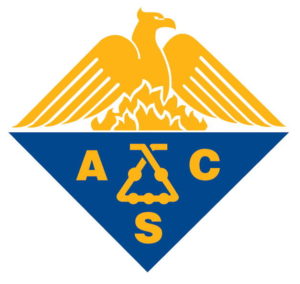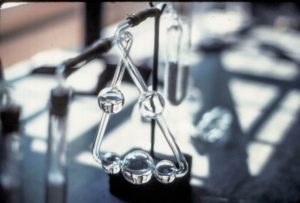by Marc Foster
The diamond-like shape of the ACS logo is one I have seen a million times yet I have never given pause to figure out what it is. There is an upper yellow triangle and a lower blue triangle. The society used to have 4 triangles representing air, fire, water and earth. Now there are just the two representing the Phoenix (gold on top) and the upper half of the square so placed, triangular in shape, shall contain the figure of a phoenix rising from the flame, typical of chemical activity and of the birth of new substance through the energy of chemical change.
The bottom triangle shows a depiction of a Kaliaapparat. A kaliapparat is a laboratory device invented in 1831 by Justus von Liebig (1803–1873) for the analysis of carbon in organic compounds. The device, made of glass, consists of a series of five bulbs connected and arranged in a triangular shape.
To determine the carbon in an organic compound with a kaliapparat, the substance is first burned, converting any carbon present into carbon dioxide (CO2). The vaporous products are passed through the kaliapparat, which is filled with potassium hydroxide (KOH) solution. The potassium hydroxide reacts with the CO2 to make potassium carbonate. The reaction, ignoring ionic dissociation, can be written as follows: 2 KOH + CO2 =>> K2CO3 + H2O.
Subtracting the mass of the kaliapparat before the combustion from that found after the combustion gives the amount of CO2 absorbed. From the mass of CO2 thus found, standard stoichiometric calculations then give the mass of carbon in the original sample.
A stylized symbol of a kaliapparat is used in the American Chemical Society logo, originally designed in the early 20th century by Tiffany’s Jewelers.
The American Chemical Society (ACS) is a scientific society based in the United States that supports scientific inquiry in the field of chemistry. Founded in 1876 at New York University, the ACS currently has more than 158,000 members at all degree levels and in all fields of chemistry, chemical engineering, and related fields. It is the world’s largest scientific society by membership.[2] The ACS is a 501(c)(3) non-profit organization and holds a congressional charter under Title 36 of the United States Code. Its headquarters are located in Washington, D.C., and it has a large concentration of staff in Columbus, Ohio.


